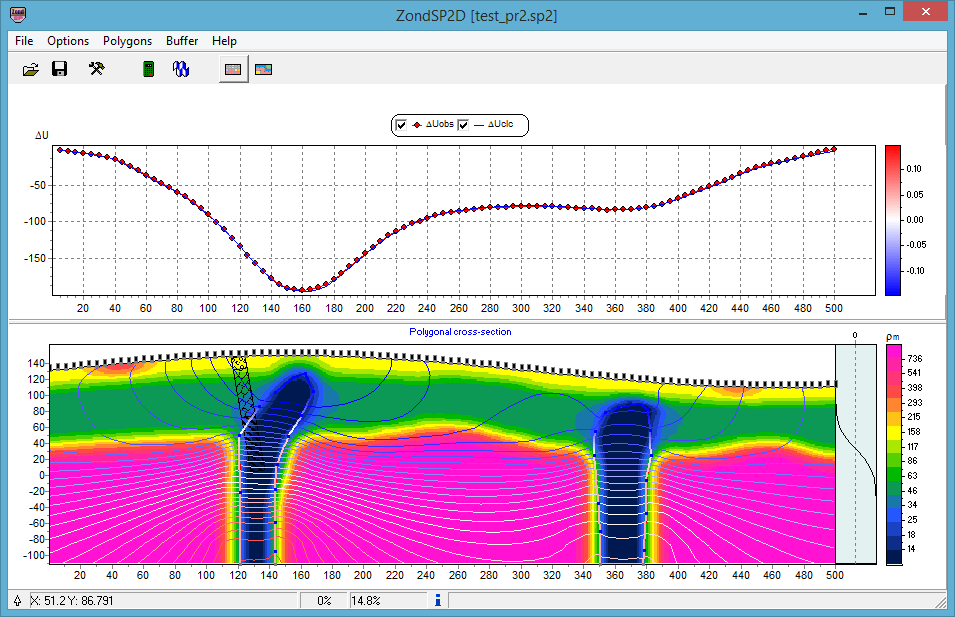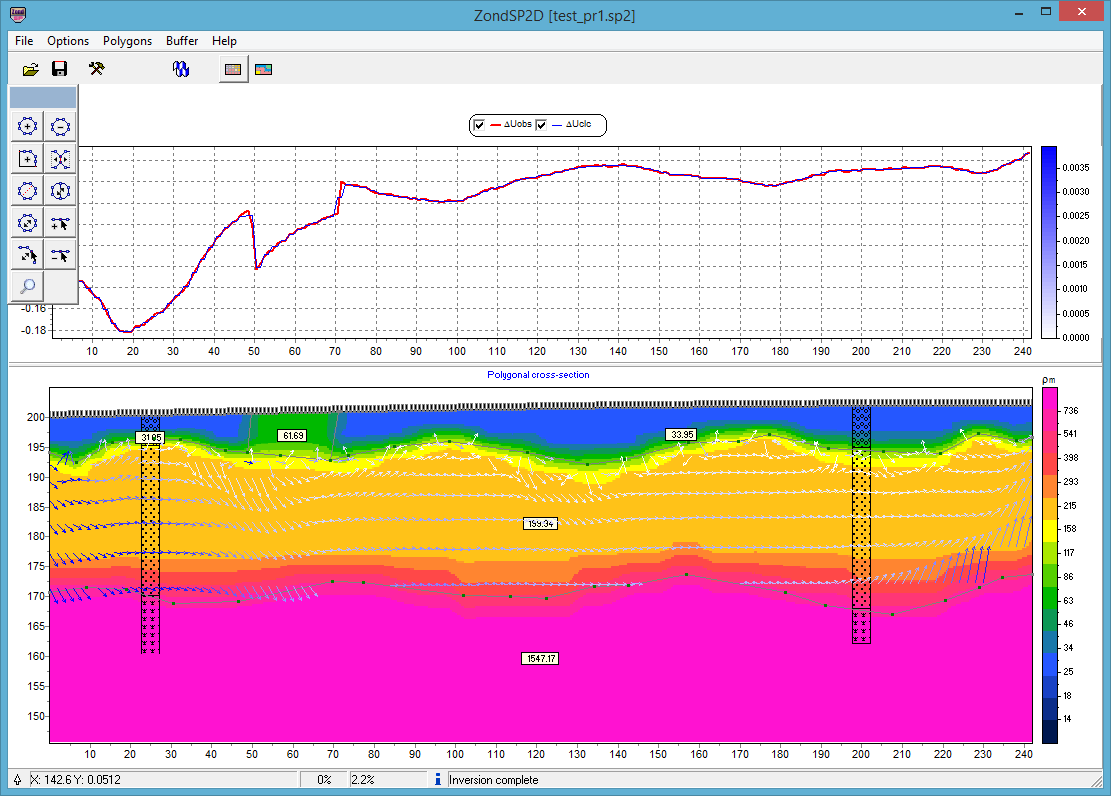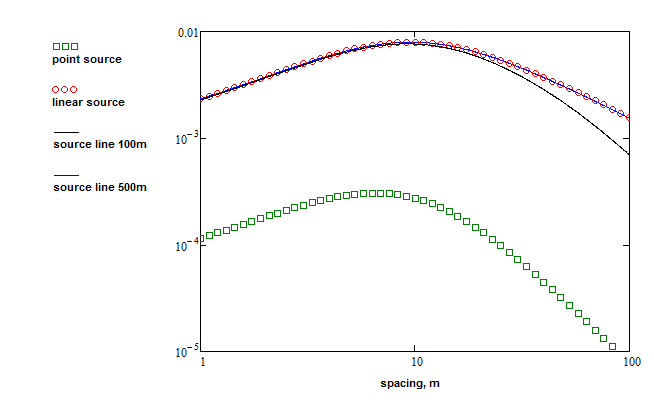ZondSP2D
ZondSP2D software is designed for two-dimensional interpretation of self-potential data. Software supports different types of sources for can be used for interpretation of different types of self-potential data.
Self-potential field method is based on studying of the natural electric fields that generate in rocks because of various physical and chemical processes. Small self-potentials of diffuse-adsorption and filtering nature exist practically everywhere. Intensive fields of redox nature are observed only over sulphide and graphite deposits. As a rule electronic conductors located in the ionic media are the search objects of self-potential field method. Electric charges as sources of natural electric field are formed on the boundaries of such objects.
 ZondSP2D represents ready solution for self-potential method, and solves wide range of problems from mathematical modeling to field data interpretation. Convenient interface and variety of data visualization features allow to solve wide range of geological problems with maximum effectiveness.
ZondSP2D uses simple and clear data format which allows easily combining various arrays and topography information. Software fully integrated with ZondRes2d software, so importing of resistivity background model is very easy.
To each object of model resistivity and sources can be assigned. Types of sources different and depends on considering problem. It can be border redox-oxygen nature sources or volumetric sources (poles or oriented dipoles). For redox-oxygen case very convenient functional is used to set source intensity vs depth. Area of volumetric sources presence can be limited by user defined polygons.
As the general task of the program is inversion of source currents, some approaches of inverse problem are used in ZondSP2D, basic of them are: probability inversion – helps to get more stable source distribution, occam inversion – can be tuned in different way to get alternative results for different settings and parametric inversion for small number of parameters problem.
ZondSP2D represents ready solution for self-potential method, and solves wide range of problems from mathematical modeling to field data interpretation. Convenient interface and variety of data visualization features allow to solve wide range of geological problems with maximum effectiveness.
ZondSP2D uses simple and clear data format which allows easily combining various arrays and topography information. Software fully integrated with ZondRes2d software, so importing of resistivity background model is very easy.
To each object of model resistivity and sources can be assigned. Types of sources different and depends on considering problem. It can be border redox-oxygen nature sources or volumetric sources (poles or oriented dipoles). For redox-oxygen case very convenient functional is used to set source intensity vs depth. Area of volumetric sources presence can be limited by user defined polygons.
As the general task of the program is inversion of source currents, some approaches of inverse problem are used in ZondSP2D, basic of them are: probability inversion – helps to get more stable source distribution, occam inversion – can be tuned in different way to get alternative results for different settings and parametric inversion for small number of parameters problem.
 Basic features:
Basic features:
 * Explanation: why linear type of source was used in the software. Linear source gives much better fitting, even size of object along strike direction (length of source line in the figure) ~ 0.3-0.5 of distance to source.
* Explanation: why linear type of source was used in the software. Linear source gives much better fitting, even size of object along strike direction (length of source line in the figure) ~ 0.3-0.5 of distance to source.
 ZondSP2D represents ready solution for self-potential method, and solves wide range of problems from mathematical modeling to field data interpretation. Convenient interface and variety of data visualization features allow to solve wide range of geological problems with maximum effectiveness.
ZondSP2D uses simple and clear data format which allows easily combining various arrays and topography information. Software fully integrated with ZondRes2d software, so importing of resistivity background model is very easy.
To each object of model resistivity and sources can be assigned. Types of sources different and depends on considering problem. It can be border redox-oxygen nature sources or volumetric sources (poles or oriented dipoles). For redox-oxygen case very convenient functional is used to set source intensity vs depth. Area of volumetric sources presence can be limited by user defined polygons.
As the general task of the program is inversion of source currents, some approaches of inverse problem are used in ZondSP2D, basic of them are: probability inversion – helps to get more stable source distribution, occam inversion – can be tuned in different way to get alternative results for different settings and parametric inversion for small number of parameters problem.
ZondSP2D represents ready solution for self-potential method, and solves wide range of problems from mathematical modeling to field data interpretation. Convenient interface and variety of data visualization features allow to solve wide range of geological problems with maximum effectiveness.
ZondSP2D uses simple and clear data format which allows easily combining various arrays and topography information. Software fully integrated with ZondRes2d software, so importing of resistivity background model is very easy.
To each object of model resistivity and sources can be assigned. Types of sources different and depends on considering problem. It can be border redox-oxygen nature sources or volumetric sources (poles or oriented dipoles). For redox-oxygen case very convenient functional is used to set source intensity vs depth. Area of volumetric sources presence can be limited by user defined polygons.
As the general task of the program is inversion of source currents, some approaches of inverse problem are used in ZondSP2D, basic of them are: probability inversion – helps to get more stable source distribution, occam inversion – can be tuned in different way to get alternative results for different settings and parametric inversion for small number of parameters problem.
 Basic features:
Basic features:
- Linear source has been used in software for calculation of forward problem*.
- Types of current sources: border redox-oxygen; volumetric: poles, horizontal dipoles, vertical dipoles, vectors.
- Supports any electrodes arrays or combinations with arbitrary receiving lines (potential and gradient array).
- Simplest text data format or possibility of importing data from arbitrary column-based text/excel file.
- Very easy to incorporate topography to model.
- Full integration with ZondRes2D software helps to import background resistivity model quickly.
- Resistivity model takes from polygons or background model.
- A set of tools for mathematical modeling based on polygonal GUI.
- Buffer for 5 models.
- Inversion algorithms : probability , occam, robust and parametric.
- Number of variants for data, model and a priori information visualization. Ability to set a semitransparent background for the resistivity section (geological, seismic sections).
- Three-dimensional visualization of results sections along arbitrary system profiles. Map of slices of parameters for various depths.
- Geological sections editor and borehole columns editor. Titled boreholes.
- Exporting to bitmap and vector graphics formats, excel, surfer, AUTOCAD. Setting the scale of the exported image. Print images and create reports.
 * Explanation: why linear type of source was used in the software. Linear source gives much better fitting, even size of object along strike direction (length of source line in the figure) ~ 0.3-0.5 of distance to source.
* Explanation: why linear type of source was used in the software. Linear source gives much better fitting, even size of object along strike direction (length of source line in the figure) ~ 0.3-0.5 of distance to source.
Version 13 / 12 / 2023 | Software: download